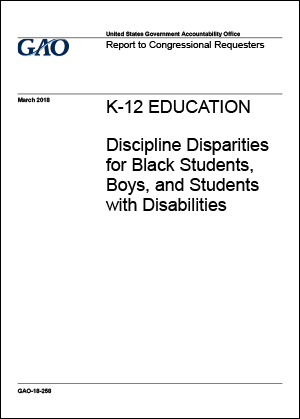 “Discipline Disparities for Black Students, Boys, and Students with Disabilities” from the Government Accountability Office (GAO) analyses the latest school discipline data (2013-14) from the Department of Education’s Civil Rights Data Collection (CRDC), five case studies of school districts that are reforming their school discipline practices and seven case studies of investigations conducted by the departments of Education and Justice into discrimination and disparities in school discipline.
“Discipline Disparities for Black Students, Boys, and Students with Disabilities” from the Government Accountability Office (GAO) analyses the latest school discipline data (2013-14) from the Department of Education’s Civil Rights Data Collection (CRDC), five case studies of school districts that are reforming their school discipline practices and seven case studies of investigations conducted by the departments of Education and Justice into discrimination and disparities in school discipline.
The CRDC collects demographic data of students receiving out-of-school suspensions, in-school suspensions, referrals to law enforcement, expulsions, corporal punishment and school-related arrests. It does not capture data on less severe disciplinary actions, such as detentions. While the report is focused on disparities in school discipline practices, it notes that students who are suspended from school are more likely to experience future involvement in the juvenile justice system through what is known as the school-to-prison pipeline.
Read the full report in the Newly Added Resources archive
The GAO analysis of the CRDC data finds that black students, boys and students with disabilities were disproportionately disciplined in K-12 public schools regardless of the kind of disciplinary action, the level of school poverty or type of school attended. The report notes that while disparities alone are not evidence that discrimination has taken place, these data raise serious concerns that a combination of intentional discrimination, policies with unjustified disparate impact, implicit bias and/or a number of other factors may account for the disparities.
The report also outlines several reforms that states, districts and schools are adopting in order to 1) comply with changing state laws, 2) settle investigations conducted by the departments of Education or Justice or 3) of their own accord.
Key reform trends include:
- Introducing Positive Behavioral Interventions and Supports (PBIS), Restorative Justice and Social and Emotional Learning (SEL) approaches to better address student behavior and minimize exclusionary discipline as a response to behavioral challenges
- Creating objective definitions of misconduct and clear criteria for penalties to minimize the potential for discretion, implicit bias and discrimination to influence school discipline practices
- Establishing clear and consistent restraint and seclusion policies to minimize their use as much as possible
- Eliminating corporal punishment in schools where it is still lawful
- Formalizing partnerships with local law enforcement to ensure that school resource officers do not administer discipline in schools.
See also: